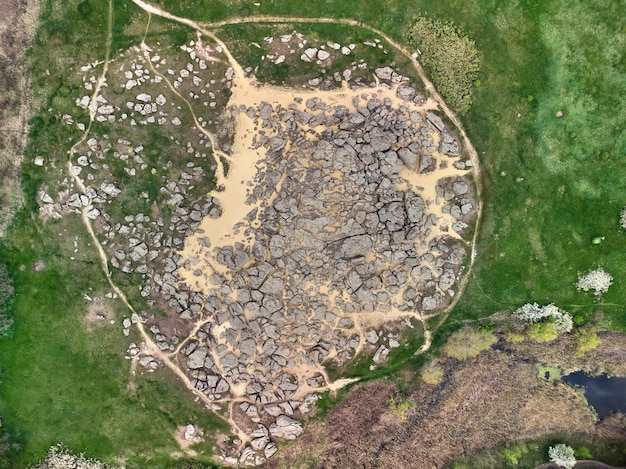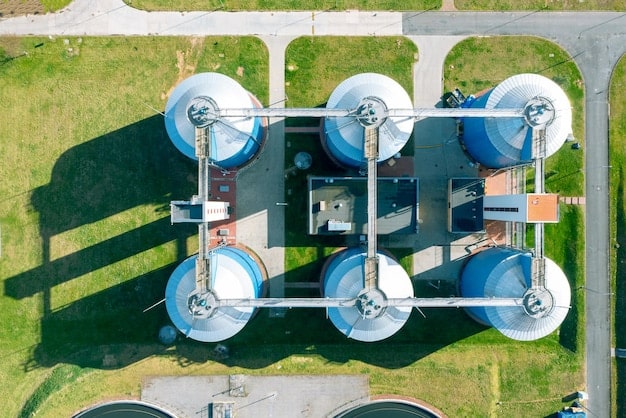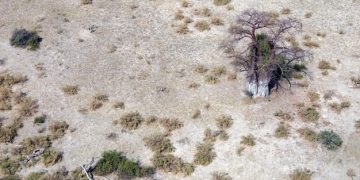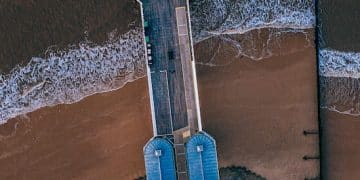US Drought: Federal Solutions for Extreme Conditions

The latest federal strategies to mitigate extreme drought conditions across the US involve a comprehensive approach combining infrastructure improvements, water conservation incentives, advanced scientific monitoring, and collaborative regional partnerships to enhance resilience and adapt to changing climate patterns.
As extreme drought conditions increasingly grip parts of the United States, threatening water security, agriculture, and ecosystems, understanding what are the latest federal mitigation strategies for extreme drought conditions across the US becomes paramount. This complex challenge demands a multifaceted response, integrating cutting-edge science with practical solutions and robust policy frameworks. From bolstering critical infrastructure to fostering community-level resilience, the federal government is deploying a range of initiatives aimed at protecting vital resources and safeguarding livelihoods.
Understanding the Drought Crisis in the US
The severity and frequency of drought in the United States have intensified dramatically over recent decades, particularly in the Western and Southwestern regions, but also impacting areas in the Great Plains and Southeast. This escalating crisis is not merely a shortage of rain; it’s a complex interplay of reduced precipitation, increased temperatures leading to greater evaporation, and changes in snowpack accumulation that affects river flows. These factors collectively deplete surface and groundwater reserves, impacting everything from drinking water supplies to agricultural productivity and wildfire risk.
The economic ramifications are profound. Agriculture, a cornerstone of the US economy, suffers immensely from water scarcity, leading to crop failures, livestock losses, and financial hardship for farmers. Beyond agriculture, drought strains urban water systems, escalates energy costs due to reduced hydropower generation, and imposes significant direct and indirect costs on communities. Ecologically, prolonged dry periods devastate natural habitats, stress wildlife populations, and increase the susceptibility of forests to disease and catastrophic wildfires. The societal costs are also considerable, including potential conflicts over diminishing water resources and the displacement of communities.
Historical Context and Evolving Challenges
Historically, the US has experienced periodic droughts, but the current era is marked by longer durations and greater intensity, often linked to climate change. This shift necessitates a re-evaluation of traditional mitigation approaches. Whereas past strategies often focused on reactive measures, the evolving context demands proactive, climate-informed planning that builds long-term resilience.
- Increased frequency of “megadroughts.”
- Persistent aridification in key regions.
- Greater demand on finite water resources from population growth.
- Complex interactions between drought, heatwaves, and wildfires.
Federal agencies are now grappling with how to address not just the immediate impacts but also the underlying drivers and future projections of drought. This involves a shift from simply reacting to water shortages to implementing comprehensive strategies that enhance water efficiency, promote sustainable land use practices, and develop robust early warning systems.
The scale of the problem requires a coordinated federal response that transcends individual agency missions, fostering collaboration across departments and with state, local, and tribal governments. This foundational understanding is crucial for appreciating the depth and breadth of the federal strategies currently being implemented to combat this pervasive environmental and economic threat across the nation.
Advanced Water Management and Conservation
At the heart of the federal government’s drought mitigation efforts lies a strong emphasis on advanced water management techniques and widespread conservation initiatives. Recognizing that traditional water supplies are finite and increasingly unreliable, federal agencies are investing in technologies and policies that optimize existing resources and reduce overall water demand. This involves a blend of innovative engineering, economic incentives, and educational programs aimed at transforming how water is used across all sectors.
One key aspect is the modernization of water infrastructure. Many existing systems for water conveyance, storage, and treatment are aging and inefficient, leading to significant water loss. Federal funding is now being directed towards projects that repair leaky pipes, upgrade pumping stations, and implement smart meter technologies that allow for more precise monitoring and management of water distribution. These investments not only conserve water but also enhance the reliability and security of water supplies for communities and industries dependent on them.
Incentivizing Water Use Efficiency
Beyond infrastructure, a major thrust of federal strategy is to incentivize water efficiency across residential, commercial, and agricultural sectors. Programs offer technical assistance, grants, and loans for adopting water-saving technologies and practices. In agriculture, this translates to supporting farmers in transitioning from flood irrigation to more efficient methods like drip irrigation and precision agriculture, which deliver water directly to plant roots. For urban areas, initiatives promote water-efficient appliances, drought-tolerant landscaping, and greywater recycling systems.
- Financial assistance for efficient irrigation systems.
- rebates for water-saving devices in homes and businesses.
- Technical support for innovative water recycling projects.
- Education campaigns on conscious water use.
The federal government also plays a crucial role in funding research and development for next-generation water technologies, such as advanced desalination techniques and wastewater treatment methodologies that can produce potable water. These forward-looking investments aim to diversify water portfolios, making communities less reliant on traditional, climate-vulnerable sources.
Furthermore, federal land management agencies, such as the Bureau of Land Management and the U.S. Forest Service, are implementing conservation practices on federal lands to improve water retention in watersheds, restore degraded ecosystems, and manage vegetation to reduce water consumption and wildfire risk. These holistic approaches recognize the interconnectedness of land, water, and climate, striving for a more sustainable and resilient water future for the entire nation.
Infrastructure Investment and Resilient Systems

Federal strategies for mitigating extreme drought are heavily reliant on significant investments in building more resilient water infrastructure. While water conservation reduces demand, robust infrastructure ensures that available water can be efficiently captured, stored, treated, and delivered where and when it’s needed most. This multifaceted approach extends beyond just pipes and pumps to encompass a wider array of interconnected systems designed to withstand the pressures of prolonged dryness and extreme weather events.
A primary focus is on expanding and improving water storage capacity. This includes funding for new reservoir construction, where environmentally feasible, and upgrading existing dams to enhance their efficiency and safety. Greater storage allows communities to bank water during periods of relative abundance, providing critical reserves during dry spells. Beyond large-scale projects, there’s also an emphasis on localized, decentralized water storage solutions, such as groundwater recharge projects and community cisterns, which increase local water security.
Modernizing Water Delivery Networks
Improving the efficiency of water delivery is another key component. Many older water conveyance systems lose substantial amounts of water through leaks, evaporation, and inefficient practices. Federal programs are supporting the replacement of aging pipelines, the implementation of pressure management systems, and the deployment of smart sensor networks that detect and pinpoint leaks in real-time. These upgrades directly translate to more water reaching its intended destination, reducing waste and increasing overall system reliability.
- Upgrading and replacing leaky pipelines.
- Implementing advanced monitoring and leak detection technologies.
- Investing in smarter grid systems for water distribution.
- Improving wastewater treatment for reuse.
Furthermore, federal investment supports the development of interconnected water systems, allowing for the transfer of water between different regions or utilities during emergencies. This “water banking” or interbasin transfer capability provides a critical safety net, ensuring that areas facing severe shortages can receive assistance from regions with more available resources. Such interconnectedness enhances regional resilience by distributing risks and sharing resources more effectively.
The focus on resilient infrastructure also includes promoting green infrastructure solutions, such as permeable pavements, rain gardens, and urban forests, which help capture and retain stormwater, reducing runoff and promoting groundwater recharge. These nature-based solutions not only mitigate drought impacts but also offer co-benefits like improved air quality, reduced urban heat island effects, and enhanced biodiversity, creating more sustainable and livable communities.
Scientific Research, Monitoring, and Forecasting
Effective drought mitigation hinges on a deep understanding of its causes, progression, and potential future scenarios. Recognizing this, federal agencies are heavily invested in robust scientific research, advanced monitoring technologies, and sophisticated forecasting models. This scientific backbone provides the critical data and insights necessary for informed decision-making, allowing federal, state, and local entities to anticipate drought conditions, implement timely interventions, and evaluate the effectiveness of mitigation strategies.
The monitoring efforts are comprehensive, spanning various hydrological, meteorological, and ecological parameters. Satellites monitor large-scale changes in land surface temperature, vegetation health, and groundwater levels. Ground-based sensors measure soil moisture, streamflow, and snowpack depth. Networks of weather stations collect data on precipitation, temperature, and humidity. This extensive data collection, often coordinated through interagency efforts like the U.S. Drought Monitor, provides a real-time, granular picture of drought conditions across the nation.
Enhancing Predictive Capabilities
Building on this wealth of data, federal scientists are developing and refining advanced climate and hydrologic models. These models integrate historical data with current conditions and future climate projections to provide more accurate and longer-range drought forecasts. Improved predictive capabilities allow water managers and agricultural producers to prepare for potential shortages months in advance, enabling them to make critical decisions about water allocations, crop planting, and land management. The National Oceanic and Atmospheric Administration (NOAA) and the U.S. Geological Survey (USGS) are prominent agencies leading these efforts.
- Development of seasonal and long-range drought forecasts.
- Use of satellite imagery for real-time water resource monitoring.
- Research into the impacts of climate change on water cycles.
- Integration of big data and AI for predictive modeling.
Federal research also explores innovative drought response technologies and practices. This includes studying new drought-resistant crop varieties, evaluating the effectiveness of cloud seeding, and understanding the complex interactions between water use, energy consumption, and ecosystem health. The aim is to identify and develop solutions that are both scientifically sound and practically implementable.
Moreover, federal agencies actively disseminate this scientific information to stakeholders through various platforms. This includes public warnings, detailed scientific reports, and decision-support tools that translate complex data into actionable insights for farmers, urban planners, emergency managers, and the general public. By empowering decision-makers with the best available science, these federal efforts significantly bolster the nation’s capacity to confront and adapt to extreme drought.
Interagency Coordination and Partnerships
Addressing the pervasive and complex challenge of extreme drought demands a highly coordinated effort that extends beyond the capabilities of any single federal agency. A cornerstone of the federal mitigation strategy is robust interagency coordination and the cultivation of strong partnerships with state, local, tribal, and private sector entities. This collaborative approach recognizes that drought impacts cut across various sectors – agriculture, water supply, energy, environment, and emergency management – requiring integrated solutions.
Numerous federal departments and agencies play critical roles in drought response. The Department of the Interior (which includes the Bureau of Reclamation, USGS, and National Park Service), the Department of Agriculture (USDA), the Environmental Protection Agency (EPA), the Department of Energy (DOE), and the Federal Emergency Management Agency (FEMA) are just a few examples. Each brings unique expertise and resources to the table, from water infrastructure management and agricultural assistance to scientific research and disaster preparedness. Effective interagency coordination ensures that their efforts are complementary, avoiding duplication and maximizing impact.
Multi-Level Collaboration
Beyond federal internal coordination, significant emphasis is placed on partnerships with non-federal entities. State governments, with their direct responsibility for intrastate water management, are key collaborators. Federal agencies work closely with state water boards, environmental protection agencies, and agricultural departments to align strategies, share data, and co-fund projects. This localized understanding is vital for tailoring solutions to specific regional needs and regulatory frameworks.
- Joint task forces and working groups on drought response.
- Sharing of data and resources across federal agencies.
- Grant programs requiring state and local cooperation.
- Public-private partnerships for innovative water solutions.
Tribal nations, many of whom have established water rights and sovereign governance over their lands, are also crucial partners. Federal agencies engage in government-to-government consultations to ensure that drought mitigation strategies respect tribal sovereignty, traditional ecological knowledge, and address the unique vulnerabilities faced by indigenous communities. These partnerships often involve support for tribal water infrastructure projects, resource management plans, and drought preparedness programs tailored to their specific needs.
Furthermore, partnerships with academic institutions, non-profit organizations, and the private sector foster innovation and expand the reach of mitigation efforts. Universities conduct vital research, non-profits advocate for conservation and community resilience, and private companies develop and deploy new water technologies. This broad network of collaboration ensures that federal strategies are informed by diverse perspectives, leverage cutting-edge advancements, and are implemented effectively at all levels, from national policy to local action.
Support for Agriculture and Rural Communities
Extreme drought conditions disproportionately impact the agricultural sector and rural communities across the United States. Recognizing the vital role of farming in the national economy and the unique vulnerabilities of these communities, federal mitigation strategies include dedicated support programs aimed at enhancing resilience, promoting sustainable practices, and providing financial relief. The Department of Agriculture (USDA) leads many of these initiatives, working directly with farmers, ranchers, and rural residents.
One primary area of support involves providing technical assistance and financial incentives for improved water management on farms. This includes programs that help producers adopt more water-efficient irrigation technologies, such as drip lines and precision sprinklers, which significantly reduce water consumption compared to traditional flood irrigation. Funds are also available for implementing soil health practices, like no-till farming and cover cropping, which enhance soil organic matter, improve water infiltration, and reduce evaporation, making land more resilient to dry spells.
Financial Assistance and Risk Management
Beyond conservation, federal programs offer crucial financial safety nets for agricultural producers facing drought-induced losses. Crop insurance programs, often subsidized by the federal government, provide critical financial relief when droughts cause significant damage to crops or livestock. Additionally, disaster assistance programs are activated during severe drought events to help farmers recover from losses, cover emergency costs, and maintain their operations. These programs act as a buffer, preventing widespread bankruptcies and ensuring the long-term viability of rural economies.
- Grants for water-efficient farm equipment and practices.
- Subsidized crop insurance for drought-related losses.
- Emergency disaster aid for affected producers.
- Conservation reserve programs to protect sensitive lands.
Federal agencies also support research and development into drought-resistant crop varieties and livestock management strategies. This includes breeding programs for plants that require less water or can withstand higher temperatures, as well as developing grazing strategies that prevent overgrazing and promote rangeland health. These scientific advancements provide farmers with better tools to cope with a changing climate and recurring drought conditions.
Furthermore, federal efforts extend to supporting broader rural infrastructure and community resilience. This includes funding for improving rural water supply systems, assisting small communities in developing drought contingency plans, and offering educational resources on water conservation. By addressing both the immediate needs of agricultural producers and the broader challenges faced by rural populations, federal strategies aim to safeguard the nation’s food supply and the livelihoods dependent on it, ensuring that these vital sectors can adapt and thrive despite increasing water scarcity.
Public Engagement and Education Initiatives
While federal policies, infrastructure investments, and scientific advancements are crucial for mitigating extreme drought, their effectiveness is greatly amplified by public understanding, participation, and a collective commitment to water conservation. Federal agencies recognize that fostering a water-conscious culture across the nation is a vital component of long-term drought resilience. As such, significant federal resources are dedicated to public engagement and education initiatives aimed at raising awareness, promoting responsible water use habits, and empowering individuals and communities to take action.
These initiatives employ a variety of communication channels, from nationwide public service announcements to targeted outreach programs in drought-stricken regions. Educational materials are developed for schools, informing students about the water cycle, the impacts of drought, and simple steps they can take to conserve water at home. Online resources, interactive tools, and social media campaigns provide readily accessible information on current drought conditions, water-saving tips, and available federal assistance programs.
Empowering Local Action
A key focus of federal education efforts is to empower individuals and communities to implement water-saving practices in their daily lives. For residential users, this involves promoting efficient appliance use, reducing outdoor watering, and fixing leaks. For businesses and industries, guidance is provided on optimizing water use in their operations and adopting best management practices. These efforts often involve collaboration with local water utilities and non-profit organizations, which have direct contact with consumers and can tailor messages to local contexts.
- Nationwide public awareness campaigns on water conservation.
- Educational materials for K-12 students about water resources.
- Online portals with drought information and water-saving tips.
- Community workshops and training programs on water efficiency.
Federal agencies also promote citizen science initiatives, encouraging the public to participate in data collection related to water quality, stream levels, or precipitation. This not only gathers valuable data but also increases public engagement and understanding of water resource challenges. By involving the public directly in monitoring and conservation efforts, these programs build a sense of shared responsibility for water stewardship.
Ultimately, the goal of federal public engagement and education initiatives is to shift societal norms towards a greater appreciation for water as a finite and precious resource. By fostering a culture of conservation, federal strategies aim to achieve widespread voluntary reductions in water demand, complementing infrastructure improvements and policy changes. This collective shift in behavior significantly strengthens the nation’s overall resilience against the increasing threat of extreme drought, ensuring a more secure water future for all.
| Key Federal Strategy | Brief Description |
|---|---|
| 💧 Water Management | Promoting conservation, efficiency, and modernizing water infrastructure across sectors. |
| 🔬 Scientific Research | Advanced monitoring, forecasting, and R&D for drought solutions. |
| 🤝 Partnerships | Coordinating efforts with state, local, tribal, and private entities for integrated response. |
| 🌾 Agricultural Support | Financial aid, technical assistance, and research for farmers to enhance resilience. |
Frequently Asked Questions About Federal Drought Strategies
▼
The primary goal is to enhance the nation’s resilience to extreme drought conditions by integrating advanced scientific understanding with practical solutions. This involves a comprehensive approach to water management, infrastructure upgrades, and collaborative partnerships, aiming to protect water resources, support affected sectors, and ensure long-term water security for communities across the country.
▼
Federal funding supports water infrastructure by investing in modernization projects, such as repairing leaky pipes and upgrading water treatment plants. It also backs the construction of new reservoirs where appropriate and promotes green infrastructure solutions like rain gardens. These investments aim to improve water retention, reduce waste, and enhance the efficiency and reliability of water delivery systems for communities.
▼
Scientific research is fundamental to federal drought strategies, providing critical data and insights. Agencies conduct extensive monitoring of water resources and climate patterns, and develop sophisticated models for drought forecasting. This scientific backbone helps anticipate conditions, inform timely interventions, and evaluate the effectiveness of mitigation efforts, ensuring strategies are evidence-based and adaptable to changing environmental realities.
▼
The federal government supports agriculture during drought through technical assistance for water-efficient farming practices, financial incentives for irrigation upgrades, and subsidies for crop insurance. It also provides emergency disaster aid to help farmers recover from losses and funds research into drought-resistant crops. These programs aim to build resilience, mitigate financial hardship, and ensure the stability of the nation’s food supply.
▼
Yes, federal agencies implement significant public engagement and education initiatives. These include nationwide public awareness campaigns, educational materials for schools, and online resources offering water-saving tips. The goal is to raise awareness about the importance of water conservation, encourage responsible water use habits, and empower individuals and communities to contribute actively to drought resilience through collective action and sustainable practices.
Conclusion
The intensifying challenges posed by extreme drought across the United States necessitate a robust and adaptable federal response. As explored throughout this discussion, the latest federal mitigation strategies are comprehensive, blending proactive measures with adaptive capacities. From significant investments in water infrastructure and advanced conservation techniques to pioneering scientific research and deep interagency coordination, the approach is designed to build long-term resilience. Crucially, these efforts extend to direct support for agricultural and rural communities, alongside expansive public engagement initiatives aimed at fostering a national culture of water stewardship. The ongoing success of these strategies hinges on continuous innovation, sustained funding, and the unwavering commitment of federal agencies, states, tribes, and the public working cohesively to secure a more water-resilient future for the nation.





